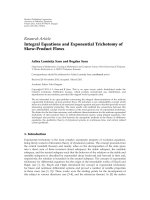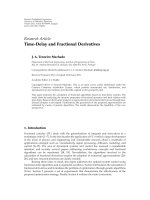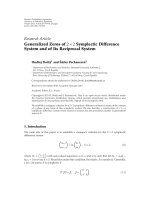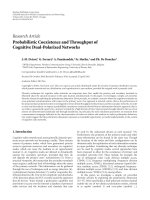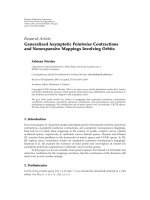Báo cáo hóa học: " INVARIANT APPROXIMATIONS, GENERALIZED I-CONTRACTIONS, AND R-SUBWEAKLY COMMUTING MAPS" pptx
Bạn đang xem bản rút gọn của tài liệu. Xem và tải ngay bản đầy đủ của tài liệu tại đây (499.24 KB, 8 trang )
INVARIANT APPROXIMATIONS, GENERALIZED
I-CONTRACTIONS, AND R-SUBWEAKLY COMMUTING MAPS
NASEER SHAHZAD
Received 11 May 2004 and in revised form 23 August 2004
We present common fixed point theory for generalized contractive R-subweakly com-
muting maps and obtain some results on invariant approximation.
1. Introduction and preliminaries
Let S beasubsetofanormedspaceX = ( X,·)andT and I self-mappings of X.
Then T is called (1) nonexpansive on S if Tx − Ty≤x − y for all x, y ∈ S;(2)I-
nonexpansive on S if Tx − Ty≤Ix − Iy for all x, y ∈ S;(3)I-contraction on S
if there exists k ∈ [0,1) such that Tx − Ty≤kIx − Iy for all x, y ∈ S. The set of
fixed points of T (resp., I) is denoted by F(T)(resp.,F(I)). The set S is called (4) p-
starshaped with p ∈ S if for all x ∈ S, the segment [x, p] joining x to p is contained in
S (i.e., kx +(1− k)p ∈ S for all x ∈ S and all real k with 0 ≤ k ≤ 1); (5) convex if S is p-
starshaped for all p ∈ S. The convex hull co(S)ofS is the smallest convex set in X that
contains S, and the closed convex hull clco(S)ofS is the closure of its convex hull. The
mapping T is called (6) compact if clT(D) is compact for every bounded subset D of
S. The mappings T and I are said to be (7) commuting on S if ITx
= TIx for all x ∈ S;
(8) R-weakly commuting on S [7] if there exists R ∈ (0,∞)suchthatTIx − ITx≤
RTx − Ix for all x ∈ S.SupposeS ⊂ X is p-starshaped with p ∈ F(I) and is both
T-andI-invariant. Then T and I are called (8) R-subweakly commuting on S [11]if
there exists R ∈ (0,∞)suchthatTIx − ITx≤Rdist(Ix,[Tx, p]) for all x ∈ S,where
dist(Ix,[Tx, p]) = inf{Ix− z : z ∈ [Tx, p]}. Clearly commutativity implies R-subweak
commutativit y, but the converse may not be true (see [11]).
The set P
S
(x) ={y ∈ S : y − x=dist(x,S)} is called the set of best approximants to
x ∈ X out of S, where dist(x,S) = inf{y − x : y ∈ S}.WedefineC
I
S
(x) ={x ∈ S : Ix ∈
P
S
(x)} and denote by
0
the class of closed convex subsets of X containing 0. For S ∈
0
,
we define S
x
={x ∈ S : x≤2x}. It is clear that P
S
(x) ⊂ S
x
∈
0
.
In 1963, Meinardus [6] employed the Schauder fixed point theorem to establish the
existence of invariant approximations. Afterwards, Brosowski [2] obtained the following
extension of the Meinardus result.
Copyright © 2005 Hindawi Publishing Corporation
Fixed Point Theory and Applications 2005:1 (2005) 79–86
DOI: 10.1155/FPTA.2005.79
80 Invariant approximations
Theorem 1.1. Let T be a linear and nonexpansive self-mapping of a normed space X,
S ⊂ X such that T(S) ⊂ S,andx ∈ F(T).IfP
S
(x) is nonempty, compact, and convex, then
P
S
(x)∩F(T) =∅.
Singh [15]observedthatTheorem 1.1 is still true if the linearity of T is dropped and
P
S
(x) is only starshaped. He further remarked, in [16], that Brosowski’s theorem remains
valid if T is nonexpansive only on P
S
(x)∪{x}. Then Hicks and Humphries [5]improved
Singh’s result by weakening the assumption T(S) ⊂ S to T(∂S) ⊂ S;here∂S denotes the
boundary of S.
On the other hand, Subrahmanyam [18] generalized the Meinardus result as follows.
Theorem 1.2. Let T be a nonexpansive self-mapping of X, S afinite-dimensional
T-invariant subspace of X,andx ∈ F(T). Then P
S
(x) ∩ F(T) =∅.
In 1981, Smoluk [17] noted that the finite dimensionality of S in Theorem 1.2 can b e
replaced by the linearit y and compactness of T. Subsequently, Habiniak [4]observedthat
the linearity of T in Smoluk’s result is superfluous.
In 1988, Sahab et al. [8] established the following result which contains Singh’s result
as a special case.
Theorem 1.3. Let T and I be self-mappings of a normed space X, S ⊂ X such that T(∂S) ⊂
S,andx ∈ F(T)∩F(I).SupposeT is I-nonexpansive on P
S
(x)∪{x}, I is linear and contin-
uous on P
S
(x),andT and I are commuting on P
S
(x).IfP
S
(x) is nonempty, compact, and
p-star shaped with p ∈ F(I),andifI(P
S
(x)) = P
S
(x), then P
S
(x)∩F(T)∩F(I) =∅.
Recently, Al-Thagafi [1] generalized Theorem 1.3 and proved some results on invariant
approximations for commuting mappings. More recently, with the introduction of non-
commuting maps to this area, Shahzad [9, 10, 11, 12, 13, 14] further extended Al-Thagafi’s
results and obtained a number of results regarding best approximations. The purpose of
this paper is to present common fixed point theory for generalized I-contraction and R-
subweakly commuting maps. As applications, some invariant approximation results are
also obtained. Our results extend, generalize, and complement those of Al-Thagafi [1],
Brosowski [2], Dotson Jr. [3], Habiniak [4], Hicks and Humphries [5], Meinardus [6],
Sahab e t al. [8], Shahzad [9, 10, 11, 12], Singh [15, 16], Smoluk [17], and Subrahmanyam
[18].
2. Main results
Theorem 2.1. Let S be a closed subset of a metric space (X,d),andT and IR-weakly
commuting self-mappings of S such that T(S)
⊂ I(S). Suppose there exists k ∈ [0,1) such
that
d(Tx,Ty) ≤ k max
d(Ix,Iy),d(Ix,Tx),d(Iy,Ty),
1
2
d(Ix,Ty)+d(Iy,Tx)
(2.1)
for all x, y ∈ S.If cl(T(S)) is complete and T is continuous, then S∩F(T)∩F(I) is singleton.
Naseer Shahzad 81
Proof. Let x
0
∈ S and let x
1
∈ S be such that Ix
1
= Tx
0
. Inductively, choose x
n
so that
Ix
n
= Tx
n−1
. This is possible since T(S) ⊂ I(S). Notice
d
Ix
n+1
,Ix
n
=
d
Tx
n
,Tx
n−1
≤ k max
d
Ix
n
,Ix
n−1
,d
Ix
n
,Tx
n
,d
Ix
n−1
,Tx
n−1
,
1
2
d
Ix
n
,Tx
n−1
+ d
Ix
n−1
,Tx
n
=
k max
d
Ix
n
,Ix
n−1
,d
Ix
n
,Tx
n
,
d
Ix
n−1
,Tx
n−1
,
1
2
d
Ix
n−1
,Tx
n
≤ k max
d
Ix
n
,Ix
n−1
,d
Ix
n
,Tx
n
,
1
2
d
Ix
n−1
,Ix
n
+ d
Ix
n
,Tx
n
≤ kd
Ix
n
,Ix
n−1
(2.2)
for all n. This shows that {Ix
n
} is a Cauchy sequence in S. Consequently, {Tx
n
} is a
Cauchy sequence. The completeness of cl(T(S)) further implies that Tx
n
→ y ∈ S and
so Ix
n
→ y as n →∞.SinceT and I are R-weakly commuting, we have
d
TIx
n
,ITx
n
≤ Rd
Tx
n
,Ix
n
. (2.3)
This implies that ITx
n
→ Ty as n →∞.Now
d
Tx
n
,TTx
n
≤ k max
d
Ix
n
,ITx
n
,d
Ix
n
,Tx
n
,d
ITx
n
,TTx
n
,
1
2
d
Ix
n
,TTx
n
+ d
ITx
n
,Tx
n
.
(2.4)
Taking the limit as n →∞,weobtain
d
y,Ty
≤ k max
d(y,Ty),d(y, y),d(Ty,Ty),
1
2
d(y,Ty)+d(Ty, y)
=
kd(y,Ty),
(2.5)
which implies y = Ty.SinceT(S) ⊂ I(S), we can choose z ∈ S such that y = Ty = Iz.
Since
d
TTx
n
,Tz
≤ k max
d
ITx
n
,Iz
,d
ITx
n
,TTx
n
,d
Iz,Tz
,
1
2
d
ITx
n
,Tz
+ d
Iz,TTx
n
,
(2.6)
82 Invariant approximations
taking the limit as n →∞yields
d(Ty,Tz) ≤ kd(Ty,Tz).
(2.7)
This implies that Ty= Tz. Therefore, y = Ty= Tz = Iz. Using the R-weak commutativ-
ity of T and I,weobtain
d(Ty,Iy) = d(TIz,ITz) ≤ Rd(Tz,Iz) = 0. (2.8)
Thus y= Ty= Iy.Clearlyy is a unique common fixed point of T and I.HenceS ∩ F(T) ∩
F(I) is singleton.
Theorem 2.2. Let S be a closed subset of a normed space X,andT and I continuous self-
mappings of S such that T(S) ⊂ I(S).SupposeI is linear, p ∈ F(I), S is p-starshaped, and
cl(T(S)) is compact. If T and I are R-subweakly commuting and satisfy
Tx− Ty≤max
Ix− Iy,dist
Ix,[Tx, p]
,dist
Iy,[Ty, p]
,
1
2
dist
Ix,[Ty, p]
+ dist
Iy,[Tx, p]
(2.9)
for all x, y ∈ S, then S∩F(T)∩F(I) =∅.
Proof. Choose a sequence {k
n
}⊂[0,1) such that k
n
→ 1asn →∞. Define, for each n,a
map T
n
by T
n
(x) = k
n
Tx+(1− k
n
)p for each x ∈ S.TheneachT
n
is a self-mapping of S.
Furthermore, T
n
(S) ⊂ I(S)foreachn since I is linear and T(S) ⊂ I(S). Now the linearity
of I and the R-subweak commutativity of T and I imply that
T
n
Ix− IT
n
x
=
k
n
TIx− ITx≤k
n
Rdist
Ix,[Tx, p]
≤ k
n
R
T
n
x − Ix
(2.10)
for all x ∈ S. This shows that T
n
and I are k
n
R-weakly commuting for each n.Also
T
n
x − T
n
y
=
k
n
Tx− Ty
≤ k
n
max
Ix− Iy,dist
Ix,[Tx, p]
,dist
Iy,[Ty, p]
,
1
2
dist
Ix,[Ty, p]
+ dist
Iy,[Tx, p]
≤ k
n
max
Ix− Iy,
Ix− T
n
x
,
Iy− T
n
y
,
1
2
Ix− T
n
y
+
Iy− T
n
x
(2.11)
for all x, y ∈ S. Now Theorem 2.1 guarantees that F(T
n
)∩F(I) ={x
n
} for s ome x
n
∈ S.
The compactness of cl(T(S)) implies that there exists a subsequence {x
m
} of {x
n
} such
Naseer Shahzad 83
that x
m
→ y ∈ S as m →∞. By the continuity of T and I,wehavey ∈ F(T) ∩ F(I). Hence
S∩F(T)∩F(I) =∅.
The following corollaries extend and generalize [3, Theorem 1] and [4,Theorem4].
Corollary 2.3. Let S be a closed subset of a normed space X,andT and I continuous self-
mappings of S such that T(S) ⊂ I(S).SupposeI is linear, p ∈ F(I), S is p-starshaped, and
cl(T(S)) is compact. If T and I are R-subweakly commuting and T is I-nonexpansive on S,
then S∩F(T)∩F(I) =∅.
Corollary 2.4. Let S be a closed subset of a normed space X,andT and I continuous
self-mappings of S such that T(S) ⊂ I(S).SupposeI is linear, p ∈ F(I), S is p-starshaped,
and cl(T(S)) is compact. If T and I are commuting and satisfy (2.9)forallx, y ∈ S, then
S
∩F(T)∩F(I) =∅.
Let D
R,I
S
(x) = P
S
(x)∩G
R,I
S
(x),where
G
R,I
S
(x) =
x ∈ S : Ix− x≤(2R + 1)dist(x, S)
. (2.12)
Theorem 2.5. Let T and I be self-mappings of a normed space X with x ∈ F(T)∩F(I) and
S ⊂ X such that T(∂S∩S) ⊂ S.SupposeI is linear on D
R,I
S
(x), p ∈ F(I), D
R,I
S
(x) is closed
and p-starshaped, clT(D
R,I
S
(x)) is compact, and I(D
R,I
S
(x)) = D
R,I
S
(x).IfT and I are R-
subweakly commuting and continuous on D
R,I
S
(x) and satisfy, for all x ∈ D
R,I
S
(x)∪{x},
Tx− Ty≤
Ix− Ix if y = x,
max
Ix− Iy,dist
Ix,[Tx, p]
,dist
Iy,[Ty, p]
,
1
2
dist
Ix,[Ty, p]
+ dist
Iy,[Tx, p]
if y ∈ D
R,I
S
(x),
(2.13)
then P
S
(x)∩F(T)∩F(I) =∅.
Proof. Let x ∈ D
R,I
S
(x). Then x ∈ ∂S∩S (see [1]) and so Tx ∈ S since T(∂S∩S) ⊂ S.Now
Tx− x=Tx− Tx≤Ix− Ix=Ix− x=dist(x, S).
(2.14)
This shows that Tx ∈ P
S
(x). From the R-subweak commutativity of T and I, it follows that
ITx− x=ITx− T x≤RTx− Ix +
I
2
x − I x
≤ (2R + 1)dist(x,S).
(2.15)
This implies that Tx ∈ G
R,I
S
(x). Consequently, Tx ∈ D
R,I
S
(x)andsoT(D
R,I
S
(x))⊂D
R,I
S
(x) =
I(D
R,I
S
(x)). Now Theorem 2.2 guarantees that P
S
(x)∩F(T)∩F(I) =∅.
Theorem 2.6. Let T and I be self-mappings of a normed space X with x ∈ F(T)∩F(I) and
S
⊂ X such that T(∂S∩S) ⊂ I(S) ⊂ S.SupposeI is linear on D
R,I
S
(x), p ∈ F(I), D
R,I
S
(x) is
closed and p-starshaped, clT(D
R,I
S
(x)) is compact, and I(G
R,I
S
(x))∩D
R,I
S
(x) ⊂ I(D
R,I
S
(x)) ⊂
D
R,I
S
(x).IfT and I are R-subweakly commuting and continuous on D
R,I
S
(x) and satisfy, for
all x ∈ D
R,I
S
(x)∪{x},(2.13), then P
S
(x)∩F(T)∩F(I) =∅.
84 Invariant approximations
Proof. Let x ∈ D
R,I
S
(x). Then, as in Theorem 2.5, Tx ∈ D
R,I
S
(x), that is, T(D
R,I
S
(x)) ⊂
D
R,I
S
(x). Also (1 − k)x + kx − x < dist(x, S)forallk ∈ (0,1). This implies that x ∈ ∂S∩S
(see [1]) and so T(D
R,I
S
(x)) ⊂ T(∂S∩S) ⊂ I(S). Thus we can choose y ∈ S such that Tx =
Iy.SinceIy = Tx ∈ P
S
(x), it follows that y ∈ G
R,I
S
(x). Consequently, T(D
R,I
S
(x)) ⊂
I(G
R,I
S
(x)) ⊂ P
S
(x). Therefore, T(D
R,I
S
(x)) ⊂ I(G
R,I
S
(x))∩D
R,I
S
(x) ⊂ I(D
R,I
S
(x)) ⊂ D
R,I
S
(x).
Now Theorem 2.2 guarantees that P
S
(x)∩F(T)∩F(I) =∅.
Remark 2.7. Theorems 2.5 and 2.6 remain valid when D
R,I
S
(x) = P
S
(x). If I(P
S
(x)) ⊂
P
S
(x), then P
S
(x) ⊂ C
I
S
(x) ⊂ G
R,I
S
(x) (see [1]) and so D
R,I
S
(x) = P
S
(x). Consequently, Theo-
rem 2.5 contains Theorem 1.3 as a special case.
The following result includes [1, Theorem 4.1] and [4, Theorem 8]. It also contains
the well-known results due to Smoluk [17] and Subrahmanyam [18].
Theorem 2.8. Let T be a self-mapping of a normed space X with x ∈ F(T) and S ∈
0
such that T(S
x
) ⊂ S.IfclT(S
x
) is compact and T is continuous on S
x
and satisfies for all
x
∈ S
x
∪{x}
Tx− Ty≤
x − x if y = x,
max
x − y,dist
x,[Tx,0]
,dist
y,[Ty,0]
,
1
2
dist
x,[Ty,0]
+ dist
y,[Tx,0]
if y ∈ S
x
,
(2.16)
then
(i) P
S
(x) is nonempty, closed, and convex,
(ii) T(P
S
(x)) ⊂ P
S
(x),
(iii) P
S
(x)∩F(T) =∅.
Proof. (i) We may assume that x ∈ S.Ifx ∈ S \ S
x
,thenx > 2x. Notice that
x − x≥x−x > x≥dist
x,S
x
. (2.17)
Consequently, dist(x,S
x
) = dist(x,S) ≤x.Alsoz − x=dist(x,clT(S
x
)) for some z ∈
clT(S
x
). Thus
dist
x,S
x
≤ dist
x,clT
S
x
≤ dist
x,T
S
x
≤Tx− x=Tx− T x
≤x − x
(2.18)
for all x ∈ S
x
. This implies that z − x=dist(x,S)andsoP
S
(x)isnonempty.Further-
more, it is closed and convex.
(ii) Let y ∈ P
S
(x). Then
Ty− x=Ty− T x≤y − x=dist(x,S).
(2.19)
This implies that Ty∈ P
S
(x)andsoT(P
S
(x)) ⊂ P
S
(x).
Naseer Shahzad 85
(iii) Theorem 2.2 guarantees that P
S
(x)∩F(T) =∅since clT(P
S
(x)) ⊂ clT(S
x
)and
clT(S
x
)iscompact.
Theorem 2.9. Let I and T be self-mappings of a normed space X with x ∈ F(I)∩F(T) and
S ∈
0
such that T(S
x
) ⊂ I(S) ⊂ S.SupposethatI is linear, Ix− x=x − x for all x ∈ S,
clI(S
x
) is compact and I satisfies, for all x, y ∈ S
x
,
Ix− Iy≤max
x − y,dist
x,[Ix,0]
,dist
y,[Iy,0]
,
1
2
dist
x,[Iy,0]
+ dist
y,[Ix,0]
.
(2.20)
If I and T are R-subweakly commuting and continuous on S
x
and satisfy, for all x ∈ S
x
∪{x},
and p ∈ F(I),
Tx− Ty≤
Ix− Ix if y = x,
max
Ix− Iy,dist
Ix,[Tx, p]
,dist
Iy,[Ty, p]
,
1
2
dist
Ix,[Ty, p]
+ dist
Iy,[Tx, p]
if y ∈ S
x
,
(2.21)
then
(i) P
S
(x) is nonempty, closed, and convex,
(ii) T(P
S
(x)) ⊂ I(P
S
(x)) ⊂ P
S
(x),
(iii) P
S
(x)∩F(I)∩F(T) =∅.
Proof. From Theorem 2.8, (i) follows immediately. Also, we have I(P
S
(x)) ⊂ P
S
(x). Let
y ∈ T(P
S
(x)). Since T(S
x
) ⊂ I(S)andP
S
(x) ⊂ S
x
, there exist z ∈ P
S
(x)andx
1
∈ S such
that y = Tz = Ix
1
.Furthermore,wehave
Ix
1
− x
=
Tz− Tx≤Iz− Ix≤z − x=d(x,S).
(2.22)
Thus x
1
∈ C
I
S
(x) = P
S
(x) and so (ii) holds.
Since, by Theorem 2.8, P
S
(x)∩F(I) =∅, it follows that there exists p ∈ P
S
(x)suchthat
p ∈ F(I). Hence (iii) follows from Theorem 2.2.
The following corollary extends [1, Theorem 4.2(a)] to a class of noncommuting maps.
Corollary 2.10. Let I and T be self-mappings of a normed space X with x ∈ F(I) ∩F(T)
and S ∈
0
such that T(S
x
) ⊂ I(S) ⊂ S.SupposethatI is linear, Ix− x=x − x for all
x ∈ S, clI(S
x
) is compact, and I is nonexpansive on S
x
.IfI and T are R-subweakly commut-
ing on S
x
and T is I-nonexpansive on S
x
∪{x}, then
(i) P
S
(x) is nonempty, closed and convex,
(ii) T(P
S
(x)) ⊂ I(P
S
(x)) ⊂ P
S
(x),and
(iii) P
S
(x)∩F(I)∩F(T) =∅.
86 Invariant approximations
Acknowledgment
The author would like to thank the referee for his suggestions.
References
[1] M.A.Al-Thagafi,Common fixed points and best approximation, J. Approx. Theory 85 (1996),
no. 3, 318–323.
[2] B. Brosowski, Fixpunkts
¨
atze in der Approximationstheorie,Mathematica(Cluj)11 (34) (1969),
195–220 (German).
[3] W.G.DotsonJr.,Fixed point theorems for non-expansive mappings on star-shaped subsets of
Banach spaces, J. London Math. Soc. (2) 4 (1972), 408–410.
[4] L. Habiniak, Fixed point theorems and invariant approximations,J.Approx.Theory56 (1989),
no. 3, 241–244.
[5] T. L. Hicks and M. D. Humphries, A note on fixed-point theorems,J.Approx.Theory34 (1982),
no. 3, 221–225.
[6] G. Meinardus, Invarianz bei linearen Approximationen, Arch. Rational Mech. Anal. 14 (1963),
301–303 (German).
[7] R. P. Pant, Common fixed points of noncommuting mappings, J. Math. Anal. Appl. 188 (1994),
no. 2, 436–440.
[8] S.A.Sahab,M.S.Khan,andS.Sessa,A result in best approximation theory, J. Approx. Theory
55 (1988), no. 3, 349–351.
[9] N. Shahzad, A result on best approximation, Tamkang J. Math. 29 (1998), no. 3, 223–226.
[10]
, Correction to: “A result on best approximation”, Tamkang J. Math. 30 (1999), no. 2,
165.
[11] , Invariant approximations and R-subweakly commuting maps,J.Math.Anal.Appl.257
(2001), no. 1, 39–45.
[12]
, Noncommuting maps and best approximations,Rad.Mat.10 (2001), no. 1, 77–83.
[13] , On R-subcommuting maps and best approximations in Banach spaces, Tamkang J. Math.
32 (2001), no. 1, 51–53.
[14]
, Remarks on invariant approximations, Int. J. Math. Game Theory Algebra 13 (2003),
no. 2, 157–159.
[15] S. P. Singh, An application of a fixed-point theorem to approximation theor y,J.Approx.Theory
25 (1979), no. 1, 89–90.
[16]
, Application of fixed point theorems in approximation theory, Applied Nonlinear Anal-
ysis (Proc. Third Internat. Conf., Univ. Texas, Arlington, Tex, 1978) (V. Lakshmikantham,
ed.), Academic Press, New York, 1979, pp. 389–394.
[17] A. Smoluk, Invariant approximations,Mat.Stos.(3)17 (1981), 17–22 (Polish).
[18] P. V. Subrahmanyam, An application of a fixed point theorem to best approximation,J.Approxi-
mation Theory 20 (1977), no. 2, 165–172.
Naseer Shahzad: Department of Mathematics, King Abdul Aziz University, P.O. Box 80203, Jeddah
21589, Saudi Arabia
E-mail address:


